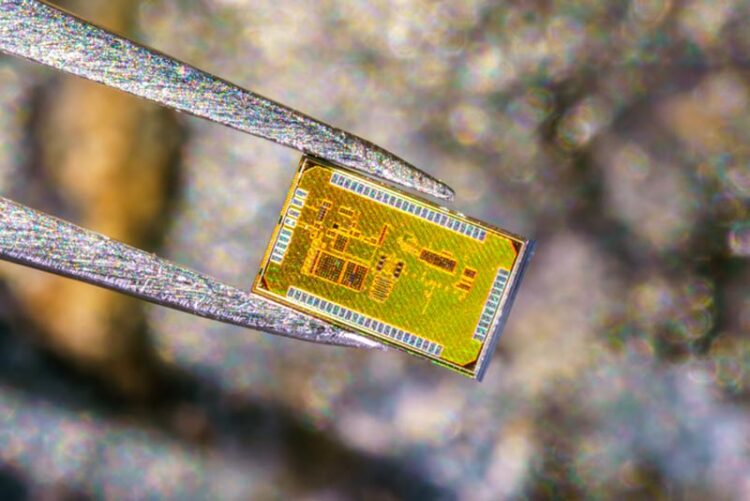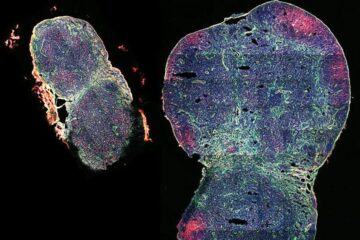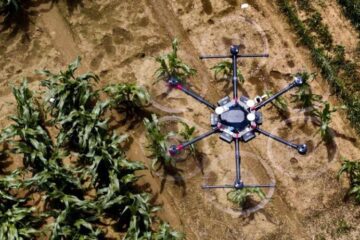New technology turns smartphones into RFID readers

The custom chip, which is roughly the size of a grain of sand and costs only a few pennies to manufacture, needs so little power that it can be entirely powered by LTE signals, a technique called RF energy harvesting.
Credit: David Baillot/University of California San Diego
– saving costs and reducing waste.
The system doesn’t require batteries, ensuring sustainable connectivity.
Imagine you can open your fridge, open an app on your phone and immediately know which items are expiring within a few days. This is one of the applications that a new technology developed by engineers at the University of California San Diego would enable.
The technology combines a chip integrated into product packaging and a software update on your phone. The phone becomes capable of identifying objects based on signals the chip emits from specific frequencies, in this case Bluetooth or WiFi. In an industrial setting, a smartphone equipped with the software update could be used as an RFID reader.
The work harnesses breakthroughs in backscatter communication, which uses signals already generated by your smartphone and re-directs them back in a format your phone can understand. Effectively, this technique uses 1000 less power than state of the art to generate WiFi signals These advances have enabled very low-power communication between components of the Internet of Things and hardware such as WiFi or Bluetooth transceivers, for applications such as on-body sensors or asset trackers.
The custom chip, which is roughly the size of a grain of sand and costs only a few pennies to manufacture, needs so little power that it can be entirely powered by LTE signals, a technique called RF energy harvesting. The chip turns Bluetooth transmissions into WiFi signals, which can in turn be detected by a smartphone with that specific software update.
The team will present their work at the IEEE International Solid-State Circuits Conference in San Francisco on Feb. 20, 2023.
Currently, state of the art backscatter modulation requires two external devices: one to transmit and one to receive and read the signals. This conference paper presents the first backscatter integrated circuit that can enable wireless communication and battery-less operation coming from a single mobile device.
“This approach enables a robust, low-cost and scalable way to provide power and enable communications in an RFID-like manner, while using smartphones as the devices that both read and power the signals,” said Patrick Mercier, one of the paper’s senior authors and a professor in the Department of Electrical and Computer Engineering at the University of California San Diego.
The technology’s broader promise is the development of devices that do not need batteries because they can harvest power from LTE signals instead. This in turn would lead to devices that are significantly less expensive, last longer, up to several decades, said Dinesh Bharadia, a professor in the UC San Diego Department of Electrical and Computer Engineering and one of the paper’s senior authors.
“E-waste, especially batteries, is one of the biggest problems the planet is facing, after climate change,” Bharadia said.
How it works
The researchers achieved this breakthrough by harvesting power from LTE smartphone signals and buffering this power onto an energy storage capacitor. This in turn activates a receiver that detects Bluetooth signals, which are then modified into reflected WiFi signals.
The software update is simply a bit sequence that turns the Bluetooth signal into something that can be more easily turned into a WiFi signal.
In addition, most lower power wireless communications require custom protocols, but the device the researchers developed relies on common communication protocols: Bluetooth, WiFi and LTE. That’s because smartphones are equipped with both a Bluetooth transmitter and a WiFi receiver.
The device has a range of one meter–about one yard. Adding a battery would boost the tag’s range to tens of meters, but also increase costs. The device, which is half a square inch in size, costs just a few cents to manufacture.
Next steps
Next steps include integrating the technology in other research projects to demonstrate its capabilities.
The team also hopes to commercialize the device, either through a startup or through an industry partner.
The work was supported by the National Science Foundation under Grant 1923902 and the UC San Diego Center for Wearable Sensors.
An LTE-harvesting BLE-to-WiFi Backscattering Chip for Single-Device RFID-like Interrogation
Shih-Jai Kuo*, Manideep Dunna*, Hongyu Lu, Akshit Agarwal, Dinesh Bharadia, Patrick Mercier, Department of Electrical and Computer Engineering, University of California San Diego
*co-primary authors
Media Contact
Ioana Patringenaru
University of California – San Diego
ipatrin@eng.ucsd.edu
Office: 858-822-0899
All latest news from the category: Information Technology
Here you can find a summary of innovations in the fields of information and data processing and up-to-date developments on IT equipment and hardware.
This area covers topics such as IT services, IT architectures, IT management and telecommunications.
Newest articles

Insect research is revolutionized by technology
New technologies can revolutionise insect research and environmental monitoring. By using DNA, images, sounds and flight patterns analysed by AI, it’s possible to gain new insights into the world of…

Expanding a lymph node, boosting a vaccine
A biomaterial vaccine enhances and sustains lymph node expansion following vaccination, boosting anti-tumor immunity in an animal model. Each one of us has around 600 lymph nodes (LNs) – small,…

AI to Make Crop Production More Sustainable
Drones monitoring fields for weeds and robots targeting and treating crop diseases may sound like science fiction but is actually happening already, at least on some experimental farms. Researchers from…





















